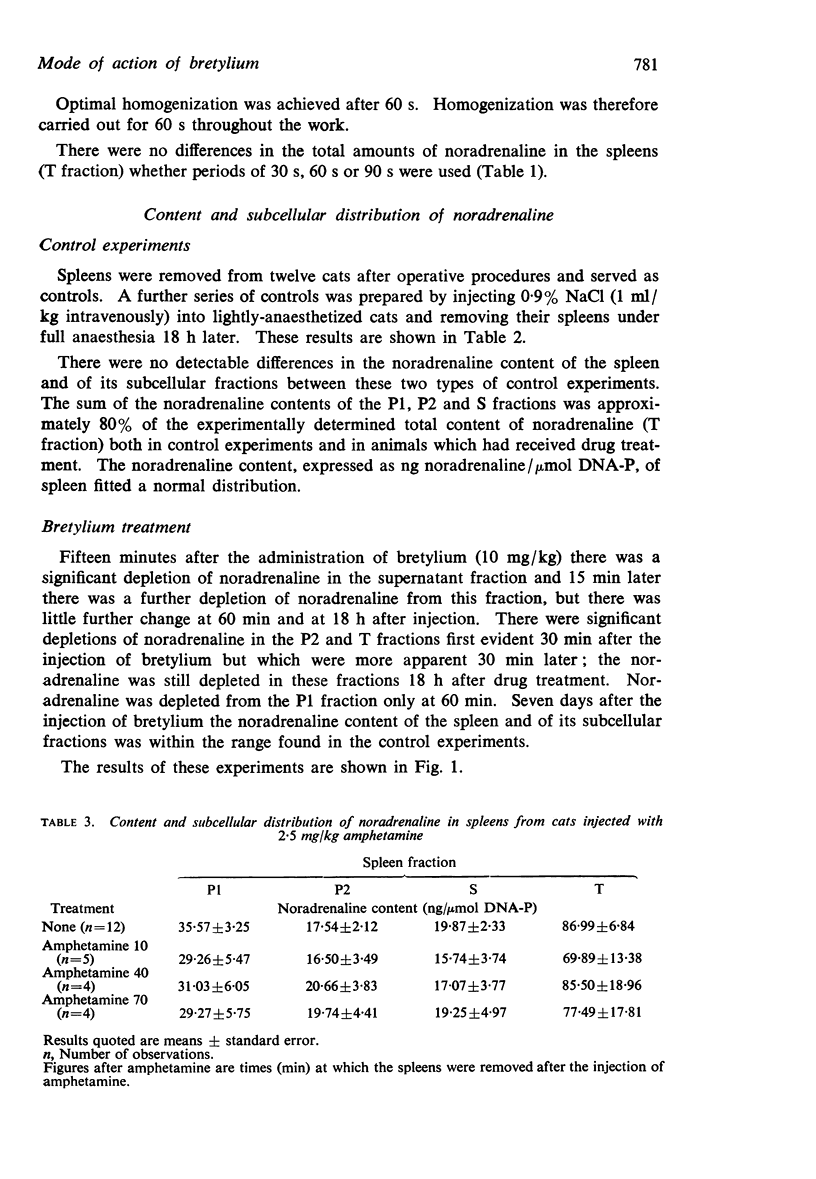Abstract
1. The effects of bretylium have been investigated on the content and sub-cellular distribution of noradrenaline in cat spleen and on the overflow of noradrenaline in response to stimulation of the splenic nerve.
2. Bretylium, 15 min after its administration, produces a significant depletion of noradrenaline in only the supernatant fraction of an homogenate; at this time adrenergic neurone blockade is evident. This depletion of noradrenaline is apparent up to 18 h later but has disappeared 7 days after the administration of bretylium when nerve function is also restored.
3. Both the development of the neurone blockade and the depletion of noradrenaline are prevented by previous administration of (+)-amphetamine.
4. In bretylium-pretreated cats the noradrenaline content of the supernatant fraction is replenished and the neurone blockade is abolished after treatment with (+)-amphetamine.
5. The depletion of noradrenaline, which is evident 30 min, 60 min and 18 h after treatment with bretylium, from other subcellular fractions—especially the high-speed particulate fraction—appears to be unassociated with adrenergic neurone blockade.
6. It is concluded that bretylium produces its adrenergic neurone-blocking activity by depleting noradrenaline from a “store” whose amine appears in the supernatant fraction after homogenization. Whilst bretylium is present this “store” cannot refill with noradrenaline.
Full text
PDF















Selected References
These references are in PubMed. This may not be the complete list of references from this article.
- Abbs E. T., Robertson M. I. A possible relationship between depletion of noradrenaline and blockade of adrenergic neurones. Br J Pharmacol. 1969 May;36(1):191P–192P. [PMC free article] [PubMed] [Google Scholar]
- Abbs E. T. The release of catechol amines by choline 2,6-XYLYL ether, bretylium and guanethidine. Br J Pharmacol Chemother. 1966 Jan;26(1):162–171. doi: 10.1111/j.1476-5381.1966.tb01818.x. [DOI] [PMC free article] [PubMed] [Google Scholar]
- BLAKELEY A. G., BROWN G. L., FERRY C. B. Pharmacological experiments on the release of the sympathetic transmitter. J Physiol. 1963 Jul;167:505–514. doi: 10.1113/jphysiol.1963.sp007165. [DOI] [PMC free article] [PubMed] [Google Scholar]
- BOURA A. L., GREEN A. F. Adrenergic neurone blockade and other acute effects caused by N-benzyl-N'N"-dimethylguanidine and its ortho-chloro derivative. Br J Pharmacol Chemother. 1963 Feb;20:36–55. doi: 10.1111/j.1476-5381.1963.tb01295.x. [DOI] [PMC free article] [PubMed] [Google Scholar]
- BOURA A. L., GREEN A. F. The actions of bretylium: adrenergic neurone blocking and other effects. Br J Pharmacol Chemother. 1959 Dec;14:536–548. doi: 10.1111/j.1476-5381.1959.tb00961.x. [DOI] [PMC free article] [PubMed] [Google Scholar]
- BURNSTOCK G., HOLMAN M. E. AN ELECTROPHYSIOLOGICAL INVESTIGATION OF THE ACTIONS OF SOME AUTONOMIC BLOCKING DRUGS ON TRANSMISSION IN THE GUINEA-PIG VAS DEFERENS. Br J Pharmacol Chemother. 1964 Dec;23:600–612. doi: 10.1111/j.1476-5381.1964.tb01613.x. [DOI] [PMC free article] [PubMed] [Google Scholar]
- CASS R., KUNTZMAN R., BRODIE B. B. Norepinephrine depletion as a possible mechanism of action of guanethidine (SU 5864), a new hypotensive agent. Proc Soc Exp Biol Med. 1960 Apr;103:871–872. doi: 10.3181/00379727-103-25702. [DOI] [PubMed] [Google Scholar]
- CASS R., SPRIGGS T. L. Tissue amine levels and sympathetic blockade after guanethidine and bretylium. Br J Pharmacol Chemother. 1961 Dec;17:442–450. doi: 10.1111/j.1476-5381.1961.tb01131.x. [DOI] [PMC free article] [PubMed] [Google Scholar]
- CHANG C. C., COSTA E., BRODIE B. B. INTERACTION OF GUANETHIDINE WITH ADRENERGIC NEURONS. J Pharmacol Exp Ther. 1965 Mar;147:303–312. [PubMed] [Google Scholar]
- Carlsson A. Modification of sympathetic function. Pharmacological depletion of catecholamine stores. Pharmacol Rev. 1966 Mar;18(1):541–549. [PubMed] [Google Scholar]
- DAY M. D. Effect of sympathomimetic amines on the blocking action of guanethidine, bretylium and xylocholine. Br J Pharmacol Chemother. 1962 Apr;18:421–439. doi: 10.1111/j.1476-5381.1962.tb01421.x. [DOI] [PMC free article] [PubMed] [Google Scholar]
- DAY M. D., RAND M. J. Antagonism of guanethidine by dexamphetamine and other related sympathomimetic amines. J Pharm Pharmacol. 1962 Sep;14:541–549. doi: 10.1111/j.2042-7158.1962.tb11137.x. [DOI] [PubMed] [Google Scholar]
- Dearnaley D. P., Geffen L. B. Effect of nerve stimulation on the noradrenaline content of the spleen. Proc R Soc Lond B Biol Sci. 1966 Dec 13;166(1004):303–315. doi: 10.1098/rspb.1966.0101. [DOI] [PubMed] [Google Scholar]
- GAFFNEY T. E., CHIDSEY C. A., BRAUNWALD E. Study of the relationship between the neurotransmitter store and adrenergic nerve block induced by reserpine and guanethidine. Circ Res. 1963 Mar;12:264–268. doi: 10.1161/01.res.12.3.264. [DOI] [PubMed] [Google Scholar]
- MOE R. A., BATES H. M., PALKOSKI Z. M., BANZIGER R. CARDIOVASCULAR EFFECTS OF 3,4-DIHYDRO-2(1H) ISOQUINOLINE CARBOXAMIDINE (DECLINAX-T.M.). Curr Ther Res Clin Exp. 1964 Apr;6:299–318. [PubMed] [Google Scholar]


